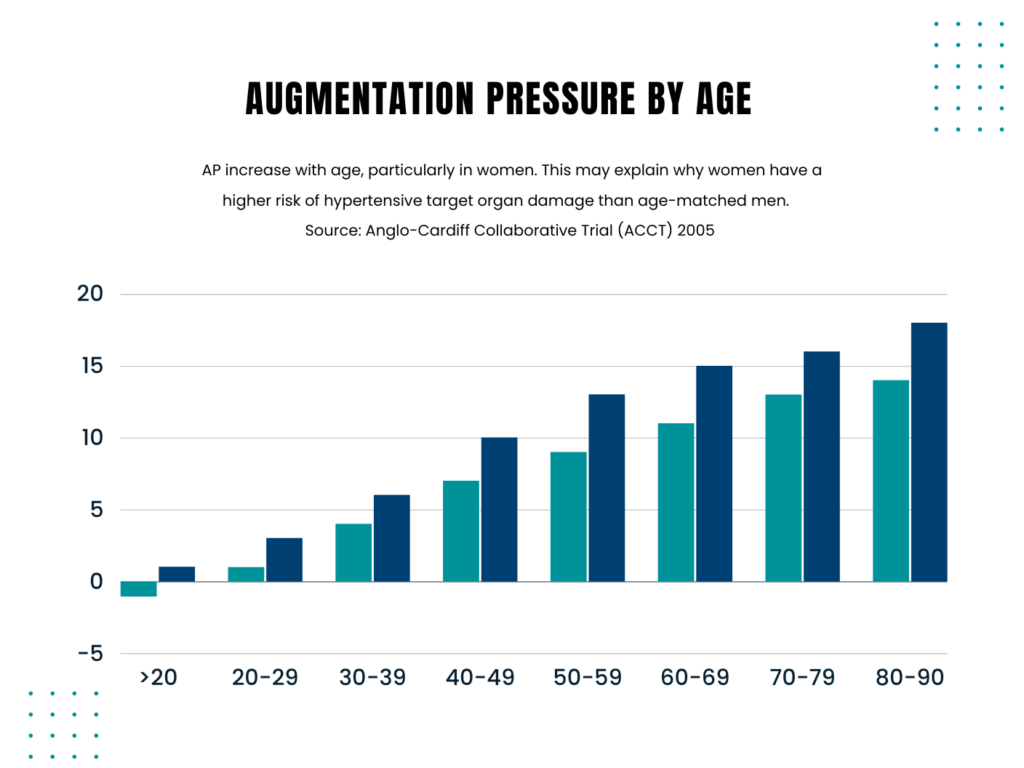Understanding Digital Vascular Biomarkers: What Is Augmentation Index?


An indirect measure of arterial stiffness that increases with age, your augmentation index reflects the burden your stiff arteries place on the heart. Chronic stress on the heart and the cardiovascular system can lead to heart failure, hypertrophy (an enlarged heart) as well as other hypertensive target organ damage such as Alzheimer’s and kidney disease.
How to Read Your Results
An ideal augmentation index is between 20-80. This suggests a healthy degree of arterial flexibility. A reading between 81-100 is considered high and should be monitored. Over 121 indicates high arterial stiffness, and by association, high cardiovascular risk.
How Is Augmentation Score Calculated?
Pulse wave reflection determines augmentation index. With each beat, the heart pushes blood out to the arteries (systole). It then relaxes or closes (diastole) as the blood comes back from the peripheral tissues. A healthy aorta doesn’t just pump out blood. It also functions like a cushion, slowing blood down as it moves while the pulse waves bounces around within elastic arterial walls. However, if the walls of the aorta become rigid, this cushioning disappears. This causes blood to move more quickly through the arteries (a phenomenon known as increased pulse-wave velocity).
When this torrent of blood reaches the narrow and fragile capillaries, it hits a wall. Some of the blood gets through, but some gets reflected back to the heart. Augmentation Index measures the augmentation of central aortic pressure by that reflected pulse wave.
Central Augmentation Index is calculated by determining the ratio of Augmentation Pressure (cAP) to Pulse Pressure (cPP): cAIx = cAP / cPP. This is known as the Central Pressure Waveform.
Why a High Augmentation Index is Dangerous
The Framingham Heart Study showed patients with increased arterial stiffness (reflected in a high Augmentation Index) were 48% more likely to develop cardiovascular disease. Loss of elasticity in the arteries predicts future risk of Type 2 diabetes than blood pressure alone, according to a study just published in Hypertension, a journal of the American Heart Association. Arterial stiffness has also been associated with the development of cerebral small vessel disease and amyloid plaques, two important biomarkers for Alzheimers.

Nine Ways to Improve Your Augmentation Index
Cardiologists typically employ a multi-step approach to treat vessel elasticity and blood pressure, starting with heart-healthy lifestyle changes like these:
1. Lose weight
Obese individuals are more likely to have increased aortic stiffness, independent of blood pressure, ethnicity, and age. According to a study in Hypertension, weight gain led to increases in arterial rigidity. Weight loss was positively associated with improvements in elasticity.
2. Cut down on sugar and fat
In one study, obese mice were fed a high-fat, high-sugar diet for five months. When they returned to their normal diet, their arterial stiffness numbers improved.
3. Get moving
Arterial elasticity can be improved in as little as four weeks with the help of aerobic exercise for healthy, yet sedentary young adults, according to a study published in Hypertension. The American Heart Association recommends 150 minutes of moderate-intensity exercise a week. This can be 75 minutes of vigorous aerobic activity, or a combination of both ideally spread throughout the week.
4. Stop smoking
Cigarettes are a vasoconstrictor, which means they make capillaries tighter, constricting blood flow to the outer tissues. Cigarettes are also a class-1 carcinogen which increases inflammation throughout the body, including the vasculature system, according to a 2010 systematic review published in Nature.
5. Check your vitamin B levels
Low vitamin B levels can compromise nitrous oxide, which hurts the whole capillary system. Folate and B 12 are particularly important. Low B vitamins can also affect homocysteine levels, which can accelerate stiffness.
6. Get more sunshine and pop some vitamin D
Deficiency is associated with increased blood pressure, arterial stiffness, vascular dysfunction, and chronic heart failure, according to a 2010 study published in Journal of American College of Cardiology.
7. Cut down on alcohol
In addition to increasing inflammation throughout your body, even moderate consumption of alcohol can deplete B vitamins, according to a 2004 study in the European Journal of Clinical Nutrition.
8. Reduce stress
In a study involving 102 Korean Americans, high stress levels were associated with increased arterial stiffening, independent of factors such as age, gender, body mass index, smoking, education and income.
9. Track your improvements
With SphygmoCor pulse wave analysis, researchers and clinicians can monitor monitor patients for changes in their augmentation index, along with other clinically relevant digital vascular biomarkers including central and peripheral systolic blood pressure, central pulse pressure, augmentation pressure, true heart rate and SEVR (subendocardial viability ratio, an indicator of how well the heart can meet the demands placed on it). Together these measurements provide a comprehensive and nuanced picture of arterial health, improving patient outcomes as optimizing the safety and efficiency of clinical trials.



